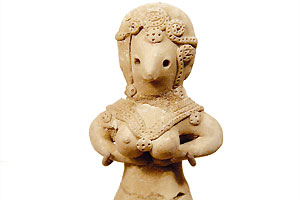The Indus swelled annually, flooding vast areas as did the Euphrates and the Tigris in Mesopotamia and the Nile in Egypt. After the water receded, the earth had been fertilized with its sediments.
The main activity of the Indus Civilization from its beginning onwards therefore, was agriculture. The main crops were wheat and barley, although legumes, sesame, dates, grapes and melons were also grown. There was rice in some places, but its consumption became widespread only when settlements reached the Ganges, in India, after 1500 B.C.
Cereals were so vital that the government collected them as tax. They were then stored in great granaries in cities and used in times of drought and scarcity.
The inhabitants of the Indus were also the first to harvest cotton and turn it into cloth to make their garments. They also bred cattle. Evidence suggests they tamed donkeys, camels, oxen, cows, goat, water buffaloes, birds and elephants.
Smiths made utensils and weapons from copper and bronze, and, occasionally gold and silver jewels. To make the latter, they also used semi precious stones such as agate, cornaline (red quartz), lapis lazuli and shells.
Besides metal objects, the great majority of the utensils that have been found were made of wood, bone, shells, flint (an intense black type of quartz) and clay, abundant in the area they inhabited.
Business
Trade seems to have been one of the main activities in the Indus Valley. Ivory, wood, cotton cloth, gems and spices were produced which were exchanged for other goods.
Oxcarts with wood wheels were used for land transport. Tin, blended with copper to obtain bronze, was imported from what is now Afghanistan and Iran, as were the semi precious stones they used to make jewels.
They also traded by sea from the port of Lothal, located today in western India. Merchant ships set sail to Dilmun (modern Bahrain), where they traded with Mesopotamian people. Some Sumerian and Acadian documents that have been discovered record trade in gold, ebony and cornaline with Indian ships.
Moreover, they seem to have had an intense commercial relationship with the neighboring Indian peoples and the Persians.
The great amount of seals (stamps) that have been found suggest that every merchant or family of merchants had one. These were used to brand their products. They were differentiated by the figure and writing engraved, and by their shape and size.
Their Art
Sculptors mastered bronze work and they also made pieces out of soap or steatite (a soft, whitish stone with a soapy surface) and also terracotta, baked earth of a gray, yellow or reddish colour.
Unlike other people of ancient times such as the Egyptians and the inhabitants if Mesopotamia, the artists of the Indus did make monumental sculptures, and even if they did make them none have been conserved. The only discoveries that have been made are of a great number of small human statues which don’t measure more than 40cm.
As in Mesopotamia, the potters of the Indus also used lathes with wheels. Their ceramics were generally red with geometrical or floral designs. They made great painted vessels for the transportation of cereals which were closed with the help of seals. These, which were made of steatite, terracotta or other materials, had sacred animals or gods and signs of their scripture (yet to be deciphered) engraved upon them. Among the relieves of animals the bull is common, probably resulting from the influence of the bulls of the Assyrian people in Mesopotamia or of the Cretan culture. Fingers of terracotta and stone have also been found which must have been used in some type of game of chance.
Polytheists
Temples or buildings made for the purpose of worship have not been found, other than a few platforms which may have been altars. Nevertheless, it is known that this people was polytheist, due to the figures of deities which have been found on the seals.
Innumerable statues of the Mother God made of terracotta have been discovered which suggests she was very commonly worshipped. She was the universal mother, the goddess of male fertility, plants and animals.
A male god endowed with horns also stands out, represented on a throne surrounded by animals.
The decline
It is believed that this civilization declined as a result of natural events such as floods, droughts, and diseases. It has also been suggested that with population increase the reserves of wood could have run out, since it is believed that the hills of northern India, now arid, were covered with forests. Wood was indispensable for baking enormous quantities of bricks, necessary for the repair and construction of their cities.
The final blow was the invasion of the European tribe of the Aryans, originating from Persia, in around 1500 B.C.
It is likely that the Aryans would have assimilated the culture of the cities of the Indus creating a new religion and society. As a result of the fusion of these cultures the so-called «Vedic Peoples» arose.








 Muere Evita
Muere Evita